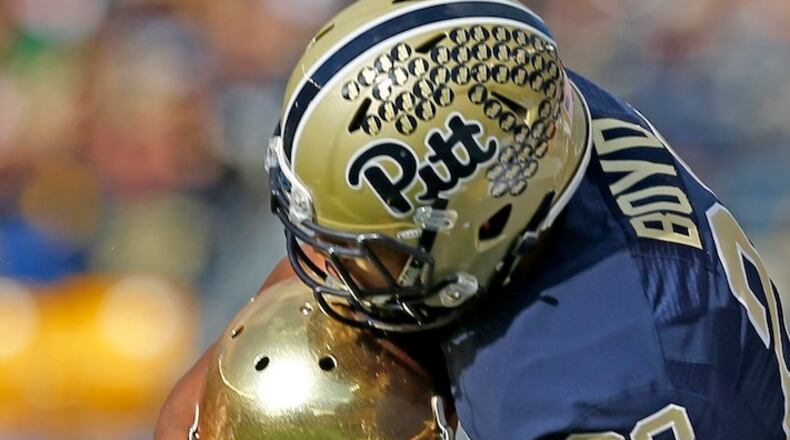Panthers fans love the Pitt Script, too. The script will not be a part of all Pitt athletic apparel until next year, but merchandise now available with the script sells. The university said sales at the Pitt Team Store and online ran 26 percent higher this October compared with last October.
“It evokes a lot of emotions among our constituents and alumni — in a positive way,” Scott Barnes, who became Pitt’s athletic director in April, said of the Pitt Script.
Few people were more thrilled to see the return of the Pitt Script than the 80-year-old Tennessean John Terrell Majors, because he was the person responsible for it.
“It has a great tradition to it,” Majors, better known as Johnny, said during a recent telephone interview. “It’s very attractive. It’s catchy. It gets your attention.”
Majors coached the Pitt football team twice, from 1973 to 1976, and from 1993 to 1996. After the Dorsett-powered Panthers went 12-0 and won the national championship in 1976, Majors left to coach at his alma mater, Tennessee.
The Pitt Script stayed.
When Majors arrived on campus from Iowa State, taking over a team that had won only one of 11 games the year before, he decided to give the program a makeover in every way. He put together a real weight room, but he also wanted his team to look good on Saturdays.
“I looked at their uniforms, and I thought they were pretty dull,” Majors said.
So Majors redesigned them. The school colors are old gold and navy blue, but Majors decided that a mustard yellow and royal blue looked sharper — in part because Pitt would not resemble the Notre Dame Fighting Irish as much.
He added double “Northwestern stripes” (one wide stripe bordered by two thinner stripes) to the jerseys and a thick blue stripe, a nod to the NFL’s Pittsburgh Steelers, to the pants. He wanted a helmet insignia that stood out in newspaper photos, on television and on magazine covers. Majors dreamed big from the start.
Majors liked the “Ucla” script insignia on UCLA’s helmets. So he told an artist, whose name he cannot remember, to draw something similar for Pitt.
When the uniform was assembled, Majors had two of his assistants, Jackie Sherrill and Joe Avezzano, model them in the press box at Pitt Stadium. The look lasted 24 seasons.
When Majors’ second stint as Pitt’s coach ended, the Panthers moved to navy blue jerseys with “Pittsburgh” in block letters on the front and shiny gold pants and helmets — which carried an insignia of a growling panther.
Majors said he never liked putting the name of his teams on the front of their uniforms.
“You learn to be recognized by the way you play,” he said.
But the insignia was worse. It was widely referred to as Dino Cat, and not in a positive way. Majors said it “looked like a dog,” pronouncing it “dawg.”
Pitt got rid of Dino Cat for a block-letter logo, and the Panthers played one game in 2005 in throwback uniforms that included the Pitt Script, but die-hard fans wanted it back for good. (A Facebook page, Free the Script, has drawn nearly 1,900 likes.) Steve Pederson, who banished the Pitt Script (not to mention Majors) after becoming the university’s athletic director in 1996, announced last October that the Pitt Script would be placed on the helmets for a home game against Georgia Tech, then for the rest of the season.
“It was kept fairly quiet,” Rowell said, “but everybody was fired up about it.”
After taking over from Pederson, Barnes announced in August that the Pitt Script was here to stay, incorporated into all of the university’s athletic uniforms by the start of the 2016-17 year. Maybe it was not such a coincidence that Pitt won six of its first seven football games.
“Everything is going in a positive direction now, and people want to be a part of it,” Rowell said.
Barnes said of the Pitt Script, “I haven’t run into anybody who didn’t want it.”
The team’s football uniforms are still navy blue and gold. But Barnes said the athletic department would do a thorough study on using what he called “accent colors,” which may include the royal blue and mustard yellow conjured up by John Majors some 42 years ago. Then the comeback will truly be complete.
About the Author
